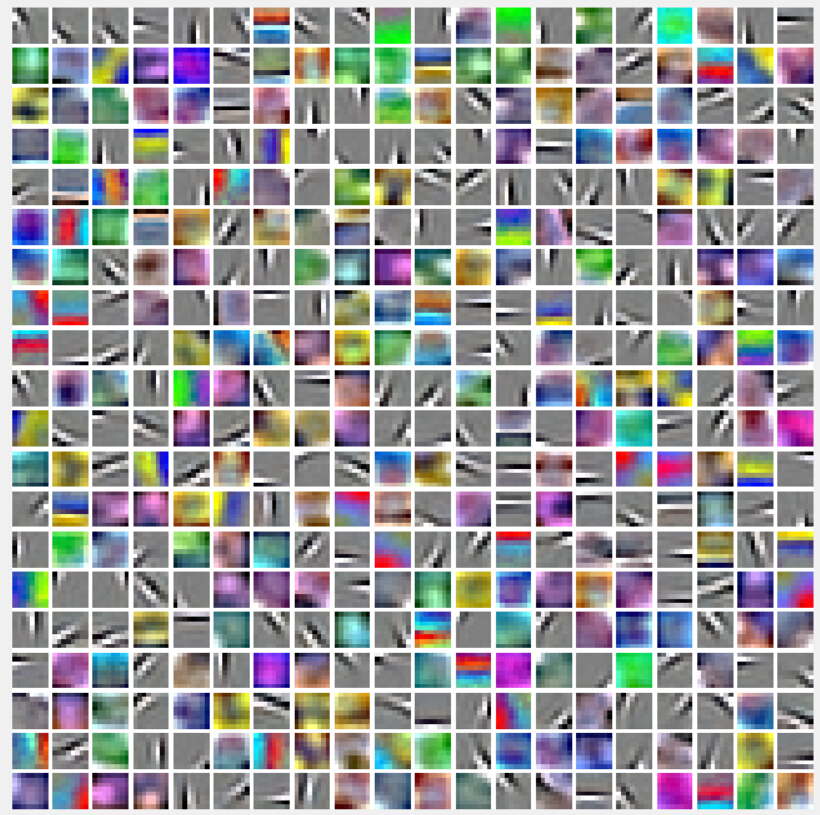教程地址:http://deeplearning.stanford.edu/wiki/index.php/%E7%BA%BF%E6%80%A7%E8%A7%A3%E7%A0%81%E5%99%A8
1.要点简述
S 型激励函数输出范围是 [0,1],当 f(z(3)) 采用该激励函数时,就要对输入限制或缩放,使其位于[0,1] 范围中。一些数据集,比如 MNIST,能方便将输出缩放到 [0,1] 中。但是有些很难满足对输入值的要求,比如, PCA 白化处理的输入并不满足[0,1] 范围要求,也不清楚是否有最好的办法可以将数据缩放到特定范围中。
a(3) = f(z(3)) =z(3)
线性激励函数(上式)可以解决这个问题。需要注意,神经网络中隐含层的神经元依然使用S型(或者tanh)激励函数。
 改变W(2) ,可以使输出值a(3) 大于 1 或者小于 0,不用再缩放输入数据。
改变W(2) ,可以使输出值a(3) 大于 1 或者小于 0,不用再缩放输入数据。
末尾层残差:


2.进入正题
In this exercise, you will implement a linear decoder (a sparse autoencoder whose output layer uses a linear activation function). You will then apply it to learn features on color images from the STL-10 dataset. These features will be used in an laterexercise on convolution and pooling for classifying STL-10 images.
对于彩色图片:
You can just combine the intensities from all the color channels for the pixels into one long vector, as if you were working with a grayscale image with 3x the number of pixels as the original image.
Step 1: Modify your sparse autoencoder to use a linear decoder
只改了很少几个地方
W1 = reshape(theta(1:hiddenSize*visibleSize), hiddenSize, visibleSize);
W2 = reshape(theta(hiddenSize*visibleSize+1:2*hiddenSize*visibleSize), visibleSize, hiddenSize);
b1 = theta(2*hiddenSize*visibleSize+1:2*hiddenSize*visibleSize+hiddenSize);
b2 = theta(2*hiddenSize*visibleSize+hiddenSize+1:end);
cost = 0;
W1grad = zeros(size(W1));
W2grad = zeros(size(W2));
b1grad = zeros(size(b1));
b2grad = zeros(size(b2));
m=size(data,2);
B1=repmat(b1,1,m);
B2=repmat(b2,1,m);
z2=W1*data+B1;
a2=sigmoid(z2);%(25,10000)
z3=W2*a2+B2;
a3=z3;%(64,10000) 这里改了
rho=sparsityParam;
rho_hat=sum(a2,2)/m;
KL=rho.*log(rho./rho_hat)+(1-rho).*log((1-rho)./(1-rho_hat));
cost=1/m*sum(sum((data-a3).^2)/2)+lambda/2*(sum(sum(W1.^2))+sum(sum(W2.^2)))+beta*sum(KL);
delta_sparsity=beta*(-rho./rho_hat+((1-rho)./(1-rho_hat)));
delta3=(a3-data); %这里改了,线性激励导数为1
delta2=(W2'*delta3+repmat(delta_sparsity,1,m)).*a2.*(1-a2);
W2grad=delta3*a2'/m+lambda*W2;
W1grad=delta2*data'/m+lambda*W1;
b2grad=sum(delta3,2)/m;
b1grad=sum(delta2,2)/m;
grad = [W1grad(:) ; W2grad(:) ; b1grad(:) ; b2grad(:)];
Step 2: Learn features on small patches
save('STL10Features.mat', 'optTheta', 'ZCAWhite', 'meanPatch'); 这几个被保存了起来,后面练习会用到。
结果图:

























 1万+
1万+











 被折叠的 条评论
为什么被折叠?
被折叠的 条评论
为什么被折叠?








